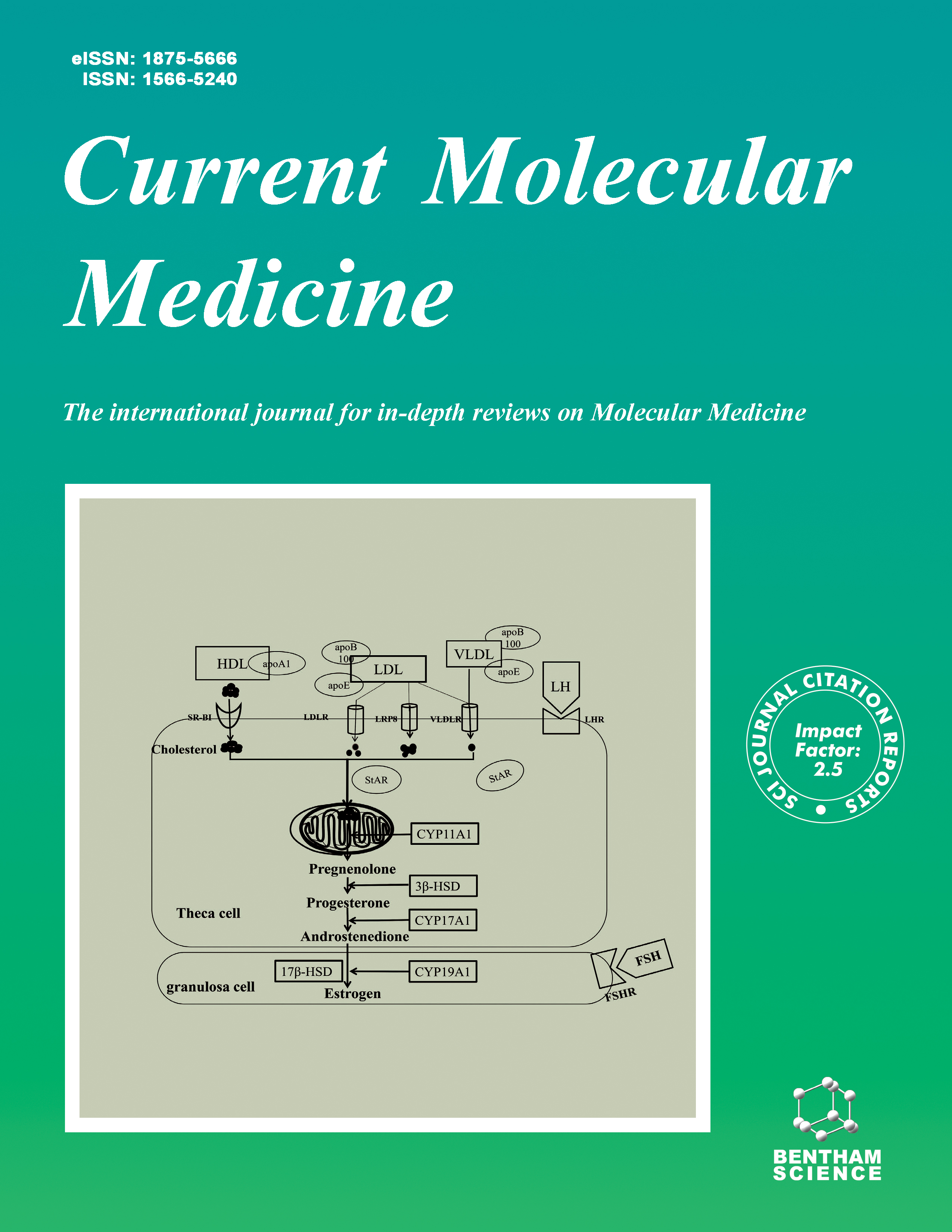- Home
- A-Z Publications
- Current Molecular Medicine
- Previous Issues
- Volume 1, Issue 1, 2001
Current Molecular Medicine - Volume 1, Issue 1, 2001
Volume 1, Issue 1, 2001
-
-
Lessons from HIV Movement of Macromolecules Inside the Cell
More LessAuthors: O.T. Fackler, B.M. Peterlin and K. WeisMolecular biological investigations of HIV have made fundamental contributions to our understanding of eukaryotic biology. These studies elucidated new paradigms in transcription, RNA and protein export from the nucleus to the cytoplasm, cellular activation, morphology and vesicular trafficking.
-
-
-
Genetics of Type 2 Diabetes Insight from Targeted Mouse Mutants
More LessDiabetes affects millions of people worldwide, and its chronic complications are a leading cause of death in many industrialized countries. In a minority of patients, diabetes is brought about by the auto-immune destruction of insulin-producing pancreatic beeta cells (Type 1 diabetes). In the vast majority of patients, diabetes is brought about by a combination of genetic and environmental factors that affect the organisms abil Read More
-
-
-
The Molecular Basis of Type 1 Glycogen Storage Diseases
More LessBy J. Yang ChouGlycogen storage disease type 1 (GSD-1), also known as von Gierke disease, is a group of autosomal recessive metabolic disorders caused by deficiencies in the activity of the glucose-6-phosphatase (G6Pase) system that consists of at least two membrane proteins, glucose-6-phosphate transporter (G6PT) and G6Pase. G6PT translocates glucose-6-phosphate (G6P) from cytoplasm to the lumen of the endoplasmic reticulu Read More
-
-
-
The Human ATP-Binding Cassette Transporter Genes From the Bench to the Bedside
More LessBy T. EfferthATP-binding cassette (ABC) transporter genes are ubiquitously present in most organisms from bacteria to man. This gene family is the largest one known as of yet. Still growing, the number of human ABC transporters counts currently 47 members which belong to seven subfamilies. ABC transporters share a similar molecular architecture (1) Full-structured transporters harbor two symmetric halves each consisting of one Read More
-
-
-
Gene Therapy for Lung Diseases Development in the Vector Biology and Novel Concepts for Gene Therapy Applications
More LessAuthors: M. Suzuki, T. Matsuse and Y. IsigatsuboThe lung represents an attractive target organ for somatic gene therapy strategy in that, (1) it is easily accessible by vectors, (2) most frequent hereditary disorders, cystic fibrosis (CF) and alpha1-antitrypsin deficiency (alpha1AT), occur in the lung, and (3) carcinoma of the lung is apparently a most common cause of death in humans. To date, approximately 400 clinical protocols for human gene therapy have been approved, Read More
-
-
-
Molecular Genetics of Left Ventricular Dysfunction
More LessAuthors: J.A. Towbin and N.E. BowlesThe left ventricle (LV) plays a central role in the maintenance of health of children and adults due to its role as the major pump of the heart. In cases of LV dysfunction, a significant percentage of affected individuals develop signs and symptoms of congestive heart failure (CHF), leading to the need for therapeutic intervention. Therapy for these patients include anticongestive medications and, in some, placement of devices Read More
-
-
-
Mitochondria in Apoptosis and Human Disease
More LessAuthors: M. Olson and S. KornbluthApoptosis is a process of cell suicide whereby individual cells are destroyed while preserving the integrity and architecture of surrounding tissue. This targeted cell destruction is critical both in physiological contexts as well as pathological states. It seems increasingly evident that mitochondria play an important role in the regulation of programmed cell death via release of proapoptotic agents and(slash)or disruption of cellular Read More
-
-
-
Vehicles for Genetic Vaccines Against Human Immunodeficiency Virus Induction of T Cell-mediated Immune Responses
More LessBy T. HankeSuccess of a candidate vaccine against human immunodeficiency virus (HIV) depends on the type, site, strength, longevity and specificity of the immune responses it induces. The specificity of a vaccine is determined by the HIV-derived immunogens it employs in its formulation. Central to the other features is a correct and efficient delivery of the immunogens to the relevant cells of the immune system, which leads to orchestr Read More
-
-
-
Natural T Cell Immunity to Intracellular Pathogens and Nonpeptidic Immunoregulatory Drugs
More LessAuthors: F. Poccia, C. Agrati, G. Ippolito, V. Colizzi and M. MalkovskyNatural T (NT) lymphocytes recognize infected cells or microbial compounds without the classical genetic restriction of polymorphic major histocompatibility complex (MHC) molecules. This innate recognition pathway results in a broad and rapid antimicrobial response that may be critical for controlling the spread of intracellular pathogens, requiring the elimination of the infecting agent from both extracellular spac Read More
-
-
-
Microdissection and the Study of Cancer Pathways
More LessAuthors: A. Maitra, I.I. Wistuba and A.F. GazdarThe study of genetic alterations in tumors and their precursor lesions is often hampered by the presence of a heterogeneous background of non-neoplastic elements such as stromal cells, inflammatory cells, and angiogenic elements. Microdissection involves the extraction of specific populations of cells under direct visualization. In this article, we will discuss the currently available techniques of microdissection, and bri Read More
-
Volumes & issues
-
Volume 25 (2025)
-
Volume 24 (2024)
-
Volume 23 (2023)
-
Volume 22 (2022)
-
Volume 21 (2021)
-
Volume 20 (2020)
-
Volume 19 (2019)
-
Volume 18 (2018)
-
Volume 17 (2017)
-
Volume 16 (2016)
-
Volume 15 (2015)
-
Volume 14 (2014)
-
Volume 13 (2013)
-
Volume 12 (2012)
-
Volume 11 (2011)
-
Volume 10 (2010)
-
Volume 9 (2009)
-
Volume 8 (2008)
-
Volume 7 (2007)
-
Volume 6 (2006)
-
Volume 5 (2005)
-
Volume 4 (2004)
-
Volume 3 (2003)
-
Volume 2 (2002)
-
Volume 1 (2001)
Most Read This Month
Article
content/journals/cmm
Journal
10
5
false
en


